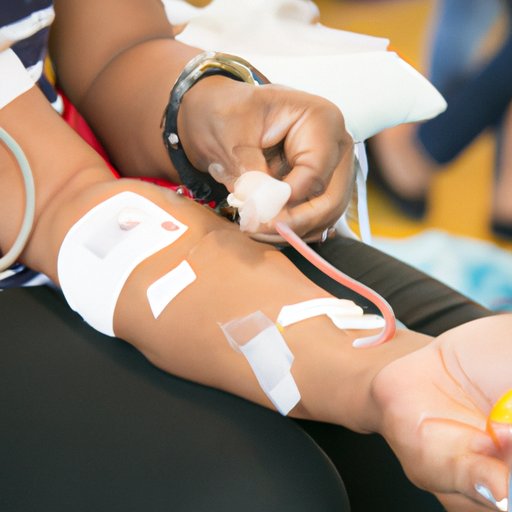
I. Introduction
Every year, millions of people donate blood to support medical treatments, emergency interventions, and ongoing research efforts around the world. While most people recognize the importance of donating blood, many still wonder about the details of the process, including how much blood is taken during each donation. In this article, we will explore the various aspects of blood donation, dispel common myths, and provide practical tips for donors seeking to make a difference.
II. What to Expect When Donating Blood: Understanding the Amount of Blood Drawn
A typical blood donation involves the removal of one pint (or 450 milliliters) of blood, which is approximately 10% of the total blood volume in an adult body. However, the specific amount of blood taken during a donation can vary based on a donor’s size, weight, and other physical characteristics.
For example, a smaller person may only be able to donate 250-300 milliliters of blood, while a larger person may be able to donate up to 500 milliliters without experiencing any adverse effects. Additionally, some types of blood donations, such as platelet donation or double red cell donation, may involve drawing a larger volume of blood in exchange for a more targeted donation product.
Overall, the amount of blood taken during a donation is designed to be both safe and effective, providing enough blood to meet urgent needs while minimizing any potential risks or side effects.
III. Dispelling Myths: Addressing Concerns Over the Quantity of Blood Taken During Donation
Despite the widespread benefits of blood donation, some people still worry about donating too much blood and experiencing negative effects as a result. However, these concerns are largely unfounded, as the human body is designed to easily replace and replenish the blood that is lost during donation.
According to the American Red Cross, an average adult body contains between 8-12 pints of blood, meaning that a single blood donation represents less than 10% of the total blood volume. Furthermore, most individuals who donate blood are able to replenish the blood that is lost within a matter of hours or days, with no long-term health implications.
Overall, donating blood is a safe and effective way to help others in need while also supporting your own health and wellbeing. While it is important to listen to your body and take care of yourself after donating, there is no need to worry about the amount of blood being taken or the impact it might have on your health.
IV. The Science Behind Blood Donation: How Much Blood is Needed to Make a Difference
While some people may underestimate the impact of blood donation, the truth is that donating even a small amount of blood can make a significant difference for patients and communities in need. Blood donations are used in a variety of medical contexts, including:
- Transfusions for patients with blood-related conditions (such as anemia or sickle cell disease)
- Surgery and other medical procedures that require replacement blood products
- Emergency interventions for trauma victims or other patients in critical condition
- Medical research and development of new treatments and cures
Specifically, a single blood donation can save up to three lives, as the donated blood is often separated into three different components (red blood cells, platelets, and plasma) that are then used to treat different patients with varying needs.
For example, one patient may require a transfusion of red blood cells to replenish lost blood volume, while another may need a platelet transfusion to support their immune system during cancer treatment. By donating blood regularly, individuals can help ensure that these critical medical interventions are always available when needed, improving health outcomes for patients around the world.
V. Maximizing Your Impact: Why the Amount of Blood You Donate Matters
While a single blood donation can make a difference, regular and recurring blood donations are truly essential for meeting the ongoing needs of patients and healthcare providers. Donating blood every 56 days (or eight weeks) is a great way to ensure that you are contributing to the cause in a consistent and meaningful way.
Furthermore, donors who are able to donate larger amounts of blood (within safe limits) can have an even greater impact on patient outcomes and medical research efforts. For example, donating double red blood cells is equivalent to donating two units of blood at once, while platelet donation can provide up to five times the amount of platelets as a single blood donation.
To maximize your impact as a blood donor, it is important to follow healthy habits and behaviors that can help ensure a successful donation process.

VI. Navigating the Donation Process: Managing Anxiety over the Blood Draw
Despite the many benefits of blood donation, some potential donors may feel anxious or fearful about the process, particularly the aspect of having blood drawn from their body. However, blood donation centers and staff are dedicated to ensuring that the process is as comfortable and stress-free as possible for all donors.
Some tips for managing anxiety over the blood draw may include:
- Eating a nutritious meal before donating and staying well-hydrated
- Bringing a friend or family member for support and companionship
- Distracting yourself during the blood draw with music, a book, or a calming breathing exercise
- Taking advantage of relaxed donation policies, such as lying down during the blood draw instead of sitting up
Overall, the goal of blood donation staff is to create a safe and supportive environment that encourages and enables donors to give blood with confidence and ease.
VII. The Benefits of Blood Donation: Exploring the Relationship Between Amount Donated and Health Outcomes
As research studies have shown, donating blood has numerous health benefits, both for individual donors and for the broader population. Some of the key health benefits associated with blood donation may include:
- Reduced risk of heart disease and stroke (as regular blood donation can help lower levels of iron in the blood, which can contribute to these health conditions)
- Lower risk of certain cancers (such as liver, lung, and colon cancer)
- Better mental health outcomes (as blood donation has been linked to reduced stress levels and enhanced feelings of wellbeing)
- Opportunities to connect with and support your local community, while also contributing to global health initiatives
These positive health outcomes are just a few of the many reasons to donate blood regularly and to encourage others to do the same.
VIII. Conclusion
As we have seen, blood donation is a vital and powerful way to support medical treatments, save lives, and improve health outcomes for individuals and communities around the world. While there is no one “correct” amount of blood to donate, the goal of blood donation centers and staff is to provide a safe and effective process for donors, while also maximizing the impact of each donation for those in need.
Whether you are a seasoned donor or a first-time donor, we encourage you to continue to support blood donation efforts in your local area and beyond. By donating blood, you can play a key role in saving lives, advancing medical research, and fostering a healthier, more connected world.




